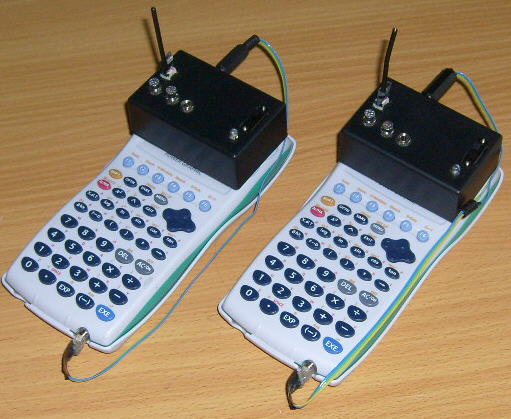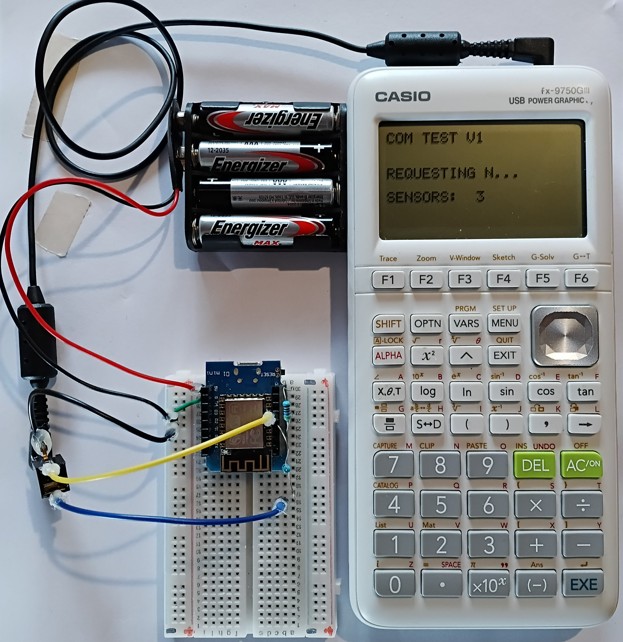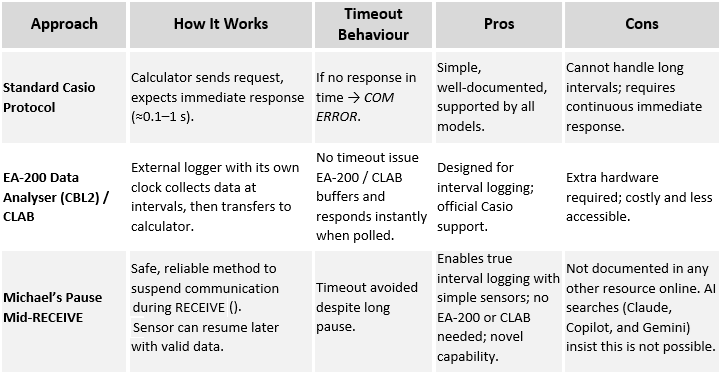Next-Generation Calculator Datalogger $10 upgrade
Providing equity and accessibility in STEM education
Michael Fenton has improved his original Picaxe-to-Casio communication protocols developed and published in the mid-2000s. The updated system transforms the Casio FX-9750 calculator family so they can sense the real world using Picaxe, ESP8266 or ESP32 microcontrollers. The open-source design encourages teacher customisation and student innovation while providing robust, classroom-tested reliability.
Michael has identified a method that allows the Casio FX 9750G and FX 9860G calculators to pause indefinitely during a RECEIVE() operation without triggering a COM ERROR. This enables external sensor units to send data at preset intervals (e.g., every 10 seconds, every minute) without requiring specialized hardware such as the EA 200 Data Analyzer, CLAB or E-Con application. Michael's system realises a hundred-fold decrease in cost.
This represents a paradigm shift from "dataloggers are for senior students only" to "every student deserves tools to investigate their world." The system has proven particularly powerful for engaging learners who traditionally see science as abstract and inaccessible, transforming them into confident, curious investigators.
This groundbreaking update to classroom-proven datalogger technology transforms standard FX-9750 and FX-9860 graphic calculators into powerful scientific instruments connecting to cheap DIY sensors. This enhanced system addresses critical equity gaps in STEM education by making authentic experimental learning accessible to junior year levels and low socio-economic communities traditionally excluded from using "expensive" laboratory equipment.

"'Wireless remote control' - older Casio calculators with black box sensor units connected. Portable and battery powered.
Key ideas
- Entirely portable and affordable on a budget: Take to the fields, the gym, on a walk, on holiday.
- Single simple Casio BASIC program: One master program connects to any microcontroller; Picaxe, Arduino, ESP8266, ESP32.
- Multi-sensor input: Connect up to 3 sensors simultaneously to a single calculator for data logging, live graphing, and statistical analysis.
- Optional wireless bi-directional communication: Over 200-metre range for remote data collection and remote equipment control. Drive a robot using your calculator!
- Web-based data sharing option: Live data served as webpages with graphs accessible on smartphones, tablets, and laptops.
- Collaborative learning: Master calculator collects data while entire groups view live results on their own devices.
- Global connectivity: WiFi enables worldwide data sharing for international collaborative projects.
- Ultra-low-cost sensors: Works with cheap low-cost DIY / home-made and low-cost sensors; measure range (distance), water vapour, temperature, pressure, alpha radiation, visible light, ultra violet (UV) light, infra red (IR) light, water hardness, salinity, static electric fields, mobile phone signals, angles, magnetic fields, and more.
- Democratising STEM Education: This system fundamentally challenges the traditional model where "fragile" and "expensive" equipment is reserved for senior students.
Imagine how much more you can engage and inspire Years 9-10 general science classes! no more having students being told to wait to use "the good" equipment, only to loose interest and be turned off science.
Where money and resourcing is a barrier to learning, a $6 USD investment provide access to science equipment normally costing $600 or more. In low-decile and resource-limited schools, as well as rural and isolated communities, this is a game changer.
This also opens up opprotunities for data logging equipment and authentic science investigations suitable for home-based and distance learners. Imagine how this could transform Science Fair investigations, with quality data from real world explorations.
Cross-curricular applications across all of the sciences, mathematics, technology, and physical education. Collect data in a PE lesson, anaylse the data in Biology or Statistics classes. Wonder if that school shade sail REALLY cuts down UV exposure? Record data over lunch, then analyse it in Physics. Explore seasonal changes saving daily recordings and looking for patterns over time in Technology class. How could the shade sail be improved?
Use Michael's proven pedagogical framework: The "Build It, Test It, Use It" approach. By constructing their own sensors learners better understand measurement principles. Calibrating equipment teaches the appreciate of data quality considerations.
Learners design authentic investigations relevant to their own questions and contexts. Learners can readily achieve Relational and Extended abstract levels on the SOLO taxonomy.
Build it
Picaxe microcontrollers are low cost. The 08M2 being small, very robust, and easily capable of communicating with the Casio graphic calculator at T9600 baud. Two (2) sensors maximum can be send data to the FX-9750GIII. Constructing a bi-directional cable is simple and low-cost, using two 2.5mm 3-pin plugs
Alternative DIY sensor units use Picaxe 14M2 or ESP microcontrollers. Up to 3 sensors can be used simultaneously.
A single master Picaxe BASIC programme works with 08M2 and 14M2 chips.
A single Casio BASIC program works with all connected microcontrollers; Picaxe, Arduino, ESP8266, ESP32.
The cable used for this demonstration photo and video is the Casio SB-62, which is a 3-pin to 3-pin crossover cable. The underlying communication is a TTL (Transistor-Transistor Logic) asynchronous serial protocol.
Warning: The Casio FX-9750 3-pin port uses a 3V TTL logic level.
A Picaxe 08M2 or 14M2 running on 2 x AA (3V) can be safely connected to the calculator.
DO NOT be connect 5V logic lines UNLESS a bidirectional logic level converter (or shifter) is used.
It IS safe to power an ESP8266 Wemos D1 mini using 4 x AAA (6V) connected to the 5V input pin, because the onboard regulator converts this to 3.3V logic at pins D6 and D5 which connect to the SB-62 plug. See the image below.

"'Build it' - receiving sensor data from a Wemos D1 mini ESP8266 sensor unit.

Test it
Experience shows students were familiar with many standard calculator functions, but learners had no experience of Casio BASIC to code their own programmes. Teacher-guided simple activities pre-tested and guaranteed to work will build learner confidence and wonderings. The new Casio BASIC code supplied to learners permits universal connection to microcontrollers and simple menu selections to begin data collection. Temperature and light intensity make good first experiences. Michael would use an introductory worksheet with three stages;
- Build your datalogger - a ‘howto’ description for connecting Casio FX-9750 to the microcontroller sensor unit. A "universal" Casio BASIC program is provided for learners to install on their own Casio calculator.
- Test your datalogger - an activity already tested by the teacher to demonstrate the datalooger has been assembled correctly and the Casio program is performing as expected. With senior classes in maths or science, it is expected some sensors would need calibrating, a useful additional skill. You could leave this for a later class activity.
- Use your data logger - introductory investigations should be teacher-led so technical problems or misunderstandings are identfied and addressed. Later, once learners are confident users, learners can design and carry out their own investigations. The Casio BASIC program can be modfied and learners are encouraged to do so. Different sensors can be used or new ones designed and tested. Again, learners and teachers are encouraged to do so.
Warning: DO NOT let students test boiling water or live electrical outlets!
There is no need to calibrate temperature sensors using boiling water. Where in the real world would a student expect to record that temperature? For some reason teachers default to using ice and boiling water to calibrate sensors. If you are investigating cooling curves, YOU should safely get sensor readings at 100 °C and PROVIDE THIS to learners.
Use it
Always remind learners that scientists work carefully and safely, no matter what they see in movies or TV!

MORE DETAILS WILL FOLLOW - including source code, lesson ideas, and learning materials. If you would like to see Michael's original work with teaching ideas and examples, click the button below.
Go to original Casio-Picaxe data logger
YouTube videos
Michael has documented many of his do-it-yourself, low-cost sensors and science equipment in YouTube videos. He is working on more material for this page. For now you can see a demonstration of the "Universal" Casio BASIC program that communicates with Picaxe or ESP8266 or ESP32 sensor units.